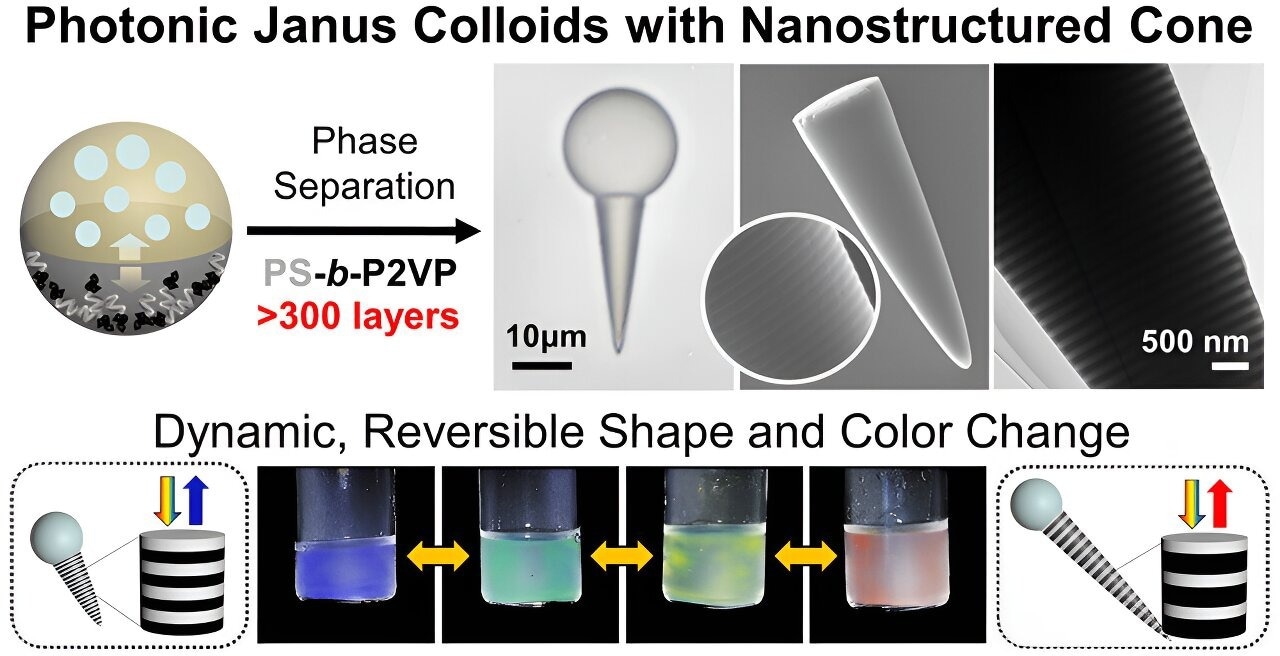Professor Kang Hee Ku and her team at the School of Energy and Chemical Engineering, Ulsan National Institute of Science and Technology (UNIST), have developed a groundbreaking technology that allows for the real-time display of colors and shapes by manipulating nanostructures. The study was published recently in ACS Nano.
 Photonic Janus colloids with nanostructured cone l. Image Credit: ACS Nano (2024). DOI: 10.1021/acsnano.4c00230.
Photonic Janus colloids with nanostructured cone l. Image Credit: ACS Nano (2024). DOI: 10.1021/acsnano.4c00230.
The researchers have utilized block copolymers to achieve the self-assembly of photonic crystal structures on a wide-ranging scale, mimicking natural occurrences witnessed in bird feathers and butterfly wings. This technology, which reflects the shape and direction of nanostructures, enables the real-time visualization of bright colors and complex patterns.
Block copolymers, which consist of two or more diverse monomers covalently bonded in a block shape, were strategically used to encourage phase separation. This separation was achieved using a non-mixing liquid droplet.
We have successfully generated hundreds of flawless photonic crystal structures through the autonomous organization of block copolymers, eliminating the need for external manipulation.
Kang Hee Ku, Study Lead Author and Professor, School of Energy and Chemical Engineering, Ulsan National Institute of Science and Technology
Distinguishing itself from conventional approaches, this innovative technology utilizes internal nanostructures to form vivid, enduring, and sustainable colors. Its enhanced applicability in display technology is obvious through its efficient patterning of large areas.
The main innovation of this technology is in the use of a polymer that can dynamically alter the microstructures’ size within particles in response to variations in the external environment. The exclusive properties of polystyrene-polyvinylpyridine (PS-b-P2VP) block copolymers allow for the tailoring of the shape, structure, and color of particles. This enables the particles to revert to their original state regardless of environmental variations.
The study includes real-time monitoring of structural alterations, showing that the color and size of micro-nanostructures adapt to variations in pH value or alcohol concentration. The particles formed via this technology exhibit an advanced "Ice Cream Cone" shape structure, merging aspects of liquids and solids to visualize fluid vibrations and dynamically change color and shape according to external stimuli.
This study opens doors to the creation of self-assembling optical particles, streamlining the complex process conditions typically associated with colloidal crystal structure and pattern formation. The technology's practical applications in smart paint and polymer particles across various industries are envisioned.
Kang Hee Ku, Professor and Study Lead Author, School of Energy and Chemical Engineering, Ulsan National Institute of Science and Technology
Journal Reference:
Lee, J., et al. (2024) Dynamic Photonic Janus Colloids with Axially Stacked Structural Layers. ACS Nano. doi:10.1021/acsnano.4c00230.